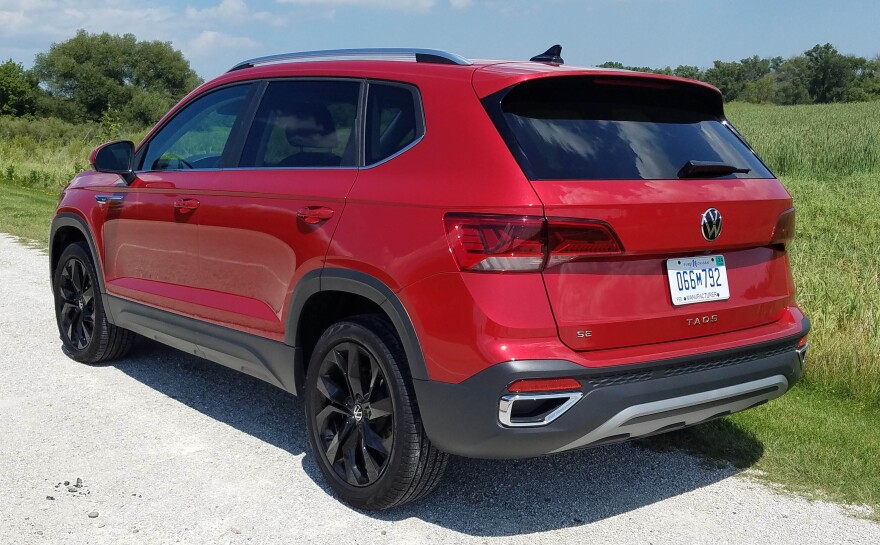The burgeoning small crossover market just added another competitor: the Volkswagen (VW) Taos. And if value is your main shopping criteria the Taos should be near the center of your bull’s-eye.
Just in the last year I’ve reviewed the following tiny crossover competitors, Mazda CX-30 (2 versions), Hyundai Venue, Mitsubishi Eclipse Cross, Kia Seltos, Chevy Trailblazer, Nissan Kicks and Subaru Crosstrek. There were others earlier as this segment has been swelling like an anaconda swallowing a warthog.
READ: 2021 Mazda CX-30 2.5 Turbo Premium Plus AWD Review
Taos (rhymes with house), VW’s smallest crossover rides on a 105.9-inch wheelbase with a potentially powerful 1.5-liter turbocharged I4 that makes 158 horsepower — 11 horses more than VW’s Jetta. That figure is near the top of this segment’s power rankings, except for the over-endowed Mazda CX-30 with its 2.5-liter turbo I4 that makes 227 to 250 hp, depending on gas selection.
For VW, this new engine is an efficient and torque-happy number with 184 pound-feet of oomph. Sadly, the test vehicle had the worst case of turbo-lag that I can recall in several years. It hesitated at every chance to accelerate. Pull from the drive, push the accelerator, and wait. Traffic light turns green, push the accelerator, and wait. Turn a corner or head onto a highway ramp, push the accelerator, and wait. Ugh!
If you want power quickly you must mash the accelerator and then there’s still a wait before that turbo launches the VW to excellent highway speeds. The waiting, followed by over-accelerating became tedious.
Too bad, because Taos seems solid and handles well and could be sporty and fun. Steering is light and easy and the crossover corners with little hint of body roll. Plus Taos is light, just 3,175 pounds. My mid-level SE model was front-drive and I suspect the 4Motion (AWD) would give it even better traction and handling. AWD costs $1,500 extra on all three trim levels.

Ride? Well, this is a short wheelbase crossover with struts up front but just a torsion beam rear suspension, so it's pretty firm. The potholes weren’t as disturbing as the raised pavement hoo-has. Taos seemed to jump a bit sideways at times on those sharp spots.
Note that the AWD models feature a multi-link rear suspension which may help ride quality some and is the system used by most vehicles these days.
An 8-speed automatic tranny handles the shifts and is aimed at fuel savings. Too bad there are no drive mode selections here to add power or maybe smooth out the performance a bit in a comfort mode. Eco seems to be where the Taos is aimed and it features strong EPA numbers. The estimates there are 28 mpg city and 36 highway. I got a fine 29.4 mpg in about 80% highway driving.
By comparison, the Trailblazer with AWD that I tested posted 32 mpg, the Mazda CX-30 with the turbo managed 26.6 and the Crosstrek posted 25.4 mpg.
READ: 2021 Chevrolet Trailblazer AWD Activ Review
Plenty of safety systems are in place with VW’s Intelligent Crash Response System and automatic post-collision braking, forward collision warning and autonomous emergency braking with pedestrian monitoring, a blind-spot monitor, and rear traffic alert being standard.
The test crossover added the IQ Drive SE package with Travel Assist (VW’s semi-autonomous driving system), smart cruise control, the Stop & Go system, and lane assist, for $895. The Travel Assist worked fine, but seemed a bit over anxious, pushing the car back toward the center or side lines harder than need be. This becomes concerning in construction zones and I could find no way to turn the system off as I dodged Wisconsin’s many orange barrels and cones.

Inside the King’s Red Metallic ($395 extra, and worth it) test vehicle was a fine interior. The SE trim upgrades cloth seats to something called CloudTex synthetic seats. This is a combo of cloth feel and faux leather, which is tough and easy to clean.
The test Taos featured gray seats with white stitching and the doors were two-tone gray while the dash was mostly dark gray with a bluish trim on some plastic bits. The console was flat black, ending sunny day reflection worries.
The SE model upgrades from the standard 6.5-inch info screen to an 8-inch touchscreen that was fairly easy to adjust. Below that are three large climate control knobs, also easy to adjust.

However, during my drive Wisconsin was sweating through a spate of muggy upper-80s days and I had to crank the climate system’s fan to its top-level to get enough cooling and leave it there for about 10 minutes. Then I slowly dialed the speed back. Air was plenty cold from the system, but it took a while to cool the interior and there is no automatic climate setting, again keeping costs down for Taos.
Seats were well-shaped giving good side and hip support and the driver’s seat was powered with a power lumbar support. The front passenger’s seat is manual. But legroom and headroom are good front and rear so it’s easy to load four to five adults in Taos, although five may prefer city jaunts to cross-country tours.
Seats are heated up front and the flat-bottomed steering wheel is also heated, a plus.
Another goodie was the huge panoramic sunroof, a $1,200 add-on. These are increasingly popular in crossovers, but this one was a monster with a gray screen over it to reduce the summer sun. But it would be fun to open in spring and fall to be sure. Might not feel like a Jeep, but definitely brings the outside in!
Another plus, a wireless phone charger under the dash’s center stack and the fact that the driver can give the instrument panel multiple looks, adding or deleting various information on either side of the speedometer.
Good news too for those hauling a lot of gear, the VW offers a generous storage area behind the rear seats with 28.1 cubic feet of space. Fold the split rear seats down and storage grows to a sizeable 66.3 cu.ft.

Now maybe the best news — pricing. VW starts with the S trim at $24,190 for front-drive and $1,500 more for AWD, known as 4Motion. The tested SE model lists at $28,440 and is FWD. A top-level SEL lists at $32,685 with AWD and a sunroof being the only options.
This Taos added 19-inch black alloy wheels with all-season tires for $395, giving the red crossover a snazzy look since it comes with black cladding over the wheel wells and front and rear fascias. Grand total here was $31,325.
That’s a bargain in today’s car world, although I’d think most Wisconsin drivers would want to add the AWD for traction and to possibly improve ride quality with the multi-link suspension.
By comparison my vehicle of the year, the hot-looking CX-30 starts at $30,050 with delivery and AWD is standard. The tested Trailblazer that is awfully cute lists at $30,070 and includes AWD while the Crosstrek is a little more at $31,440 with AWD and heated and cooled seats, plus a fancy stereo.
As you can see, pricing in this segment is quite close, so test drive several small crossovers before you buy and compare them with like features. This is a well-stocked market with Taos being the new kid on the block!

Overview: 2022 VW Taos SE
Hits: Light easy handling, huge panoramic sunroof, roomy interior, heated well-shaped seats, flat-bottom heated steering wheel, big storage area, wireless charger, multiple dash views, value pricing and good gas mileage.
Misses: Firm ride and concerning turbo lag on acceleration. Couldn’t turn off active lane control, no drive modes to boost acceleration, fan must be turned on top level for quite a while to cool crossover on hot day.
Made in: Puebla, Mexico
Engine: 1.5-liter turbo I4, 158 hp
Transmission: 8-speed automatic
Weight: 3,175 lbs.
Wheelbase: 105.9 in.
Length: 175.8 in.
Cargo: 28.1/66.3 cu.ft.
MPG: 28/36
Base Price: $28,440
Invoice: $27,351
Major Options: 19-inch black alloy wheels w/all-season tires, $395
King’s Red metallic paint, $395
Power panoramic sunroof, $1,200
IQ Drive SE package (Travel Assist semi-autonomous drive assistance, adaptive cruise control, stop & go, lane assist, blind-spot monitor), $895
Test vehicle: $31,325
Sources: Volkswagen, Kelley Blue Book
Editor's Note: Mark Savage's auto review column, Savage On Wheels, looks at a new vehicle every week and tells consumers what’s good, what’s not so good, and how the vehicle fits into the marketplace.







